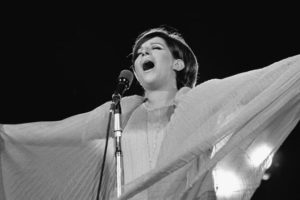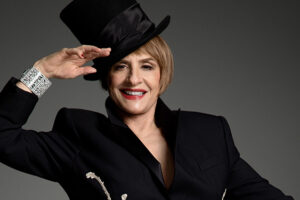

But the very mode of success of this production—still, a success d’estime and not, really the achievement of an enjoyable evening—raised some questions in my mind at least as to whether the cultural values embodied in the production could travel easily to many of our metropolitan centers, overcome as they are with the pall of political correctness.
Gian Carlo Menotti‘s story is very much of its time—or should I say, very much of the time of an older generation which saw the changes in the early 60’s, culturally and politically, as matter of condescension. It is basically My Man Godfrey, but on a global scale, and the it tells of an attempted arranged marriage between a wealthy American and Indian which goes awry when the American heiress falls in love with the low-caste “savage” she has been attempting to civilize.
The inherent story isn’t nasty or mean-spirited; Menotti clearly has some lovely morals to scatter about on how love should overcome economic barriers and even (to some extent) religious/national barriers (Kitty marries the Indian and goes to live in a cave, but at the end tells her father to start bringing in refrigerators and so on, and there”s no doubt how this will end up).
In a nutshell, Menotti feels that it is good and decent to cross barriers for romantic love, but he’s not one to advocate changing the relative value of the different cultures, and his stereotyped attitude towards men and women is just one instance of this. Lest we consider him merely a prisoner of his own times, one need only think of Fidelio or, for that matter, My Fair Lady.
This attitude even more painfully obvious in the great party scene in Act II, where the Savage (Abdul – it kind of had to be, didn’t it?) is now being presented at a large cocktail party in Chicago. Menotti makes feeble and really rather embarassingly half-hearted attempts to crticize both the dominant society (military conscription, political campaigning) and then, having shown his “good faith” as a social critic of the status quo, goes after “modern” art in all of its forms—visual, poetic and musical, with a series of stereotypes: a scatter-paint type (in this production, made to look like a fat Warhol), a poet of two words (made to look like Ginsberg moving with a suppository —this isn”t “Howl,” but bowel), and of course the academic composer.
There were, of course, just these battles raging then, but Menotti’s slyness doesn’t even have the embarassment inherent in Norman Rockwell going after Mark Rothko; what you have is Bob Barker making fun of Ralph Richardson’s overnights in the Nielsen ratings.
You can see how difficult this would be to make come alive on stage. Director Ned Canty has taken, probably, the only avenue one can with this, which is to create a broad parody of the work which (hopefully) will make the audience forget both the tedium of the libretto and much of the music (although, truth be told, a number of the arias and duets are quite lovely in themselves, and show Menotti had lost nothing of a real melodic gift, no matter how conservative the idiom or how derivative the sources).
You can’t “ennoble” the Indians and keep them funny, and so in fact what you get is basically the Hindu version of Stepin’ Fetchit. There are a dozen Indian chorus guys, all scrawny, all wearing turbans and matching Depends (that’s just what it looks like, intentionally), with body suits to make them look tatooed all over, and with identical beards (on all 12) that make them look like the Smith brothers. They don”t have an XY chomosome, or for that matter three neurons, among them, and are cowardly and inefficient and barely human.

The younger Indian couple are more palatable, but of course the son is half-American, and his beloved hasn’t much to do but be obedient and be loved. Wherever he could, Canty emphasized the grotesque characteristics—the Maharanee has to be wheeled in on a barrel and looks like a pneumatic doll; the Maharajah can’t even juggle two balls (sic).
Canty tries as hard as he can, I think, to even this up on the American side, though not with the main characters, who are played rather straight and endearingly for the audience. The great party scene takes a swipe at everything—it looks like a very bad staging from Sondheim’s Merrily We Roll Along – and charity makes me believe that the extremely nasty view of homosexual men (the designers—who go well beyond anything in the score —and the waiters, who make their own sexuality clear by wiggling their asses and mincing around) is really just an attempt to say, “Look, I’m just trying to offend everyone.” But I suppose everyone has their limits, and I was less happy in the scene with all the religious breathren trying to convert Abdul (what a scene that would be today!) with the rabbi wearing a talis. Why? What else was he with the yarmulke?
Canty, to his credit, changes the ending slightly, and to everyone’s advantage—rather than ending with more and more American goods being brought into Adbul’s cave (as Menotti writes in the stage directions), Canty quickly changes the scene into a museum display of Abdul and Kitty in a diorama which modern school children are passing by, and if this doesn’t quite excuse three hours of outdated libretto, it shows a wit and snese of humor that are much needed to end the evening of over three hours.
I just don’t think you could get away with this in many cities. I really didn’t object, and if I didn’t laugh, I admired the attempt to solve the insoluble. But I suspect in a lot of places the Indian scenes would get (self) righteously booed off the stage, at the least. My view is that it’s to Santa Fe’s credit that they didn’t, but I never underestimate a subscriber to The New York Times.
It doesn’t really matter how deliberately Menotti is updating bel canto comic opera—that’s too obvious to need discussion, and beyond the plotting, it appears in everything from musical form (a patter song, for example, for Kitty the heiress’s father) to the soprano cadenzas, the distribution of parts (the second soprano—at the Met, the young Teresa Stratas) singing music less florid and a third below the prima donna), and the larger musical structures (though I confess to finding it quite charming that the lovely final duet is deliberately reminscent of Rosenkavalier‘s final duet).
John Guare remembered once being told as a young writer that you had to observe people closely and in all intense detail, in order to get “characters” on the page; if you start out only with your “imagination,” he was told, you only ended up with cartoon characters. I doubt that Menotti was ever given this advice, and certainly he never would have understood it, and at the heart of any Menotti work seems to be a series of cartoons.
You may find then effective (although I think even the Consul could do better with less overstatement, although I know others here I respect disagree), but they are never more than cartoons. Opera isn’t pure dramatic literature, obviously, and Norina isn’t supposed to be in A Doll’s House, but even the generalized opera chatacter, or the commedia dell’arte, has to be anchored in an emotional matix of which we can each feel ourselves part. For a man who want to criticize academic composers, academicism is Menotti’s worst sin here.
Alan Moyer shows that he is once again one of our most brilliant stage designers in opera, and if there really is a single star who made the evening tolerable, it was he. He was endlessly inventive, full of unexpected visual jokes, luscious sets (on a budget), wonderful and evocative colors, all without descending to the trite.
Of the singers, much of the attention was on Daniel Okulitch, a tall, handsome strapping (bass?) baritone who was unclothed as much as humanly possible, and drew wolf whistles in Act III. He has the upper body of Johnny Weissmuller and the general stature of Max Baer, Jr., in case you were wondering. You’d guess he was a swimmer specializing in the butterfly stoke to look at him (and if you pretend not to have these thoughts, you are a total liar), but he even looked more interesting in white tie and tails, rather like a muscular Humphrey Bogart. Most importantly, as in everything I have seen him in before, he is a real singing actor, and gave a genuine “performance,” acting and not attitudinizing. He may not have the most luxurious of voices, but he is a commited singing actor, not just another “barihunk.”
Sean Pannikar, as the young heir to the Indian throne (I believe he is Sri Lankan in background?) has never really impressed me with the vocal goods, and I still don’t hear much body in the voice at all. The tenor was one of Opera News‘ Monthly singers a while back, which is usually the kiss of death, but his diction was very clear and he has improved greatly as an actor.
Anna Christy, heard more often at the ENO than here in the U.S., was fine on stage and in a range repeatedly hitting the acuti, including Ebs and an E, although I think the voice more or less anonymous at this point. Kevin Burdette (who for some reason didn’t get a biography) was first rate, I thought, at Mr. Scattergood, and I thought Jennifer Zeitlan as Sardula (the second donna) lovely in her aria.
The orchestra was conducted by George Manahan, late of City Opera, and he got lots of approval from the orchestra, perhaps as much for his very incisive conducting (much better than Schippers in the prima, if you ask me) as perhaps for his travails at City.
Photos: Ken Howard.























Comments